Strategic Management of Coles Supermarket: A Detailed Report
VerifiedAdded on 2023/06/09
|10
|3069
|173
Report
AI Summary
This report offers a comprehensive strategic management analysis of Coles Supermarket within the Australian retail industry. It begins with a macroenvironmental analysis using the PESTLE framework, followed by an industry analysis that includes the life cycle stage and Porter's Five Forces. A detailed company analysis is presented, utilizing the value chain and VRIO models to assess Coles' internal capabilities and competitive advantages. The report further examines competitor strategies and concludes with strategic recommendations and predictions for the future of the Australian retail market. The analysis highlights key factors influencing Coles' performance and provides insights into its competitive position relative to rivals like Woolworths, Aldi, and IGA.
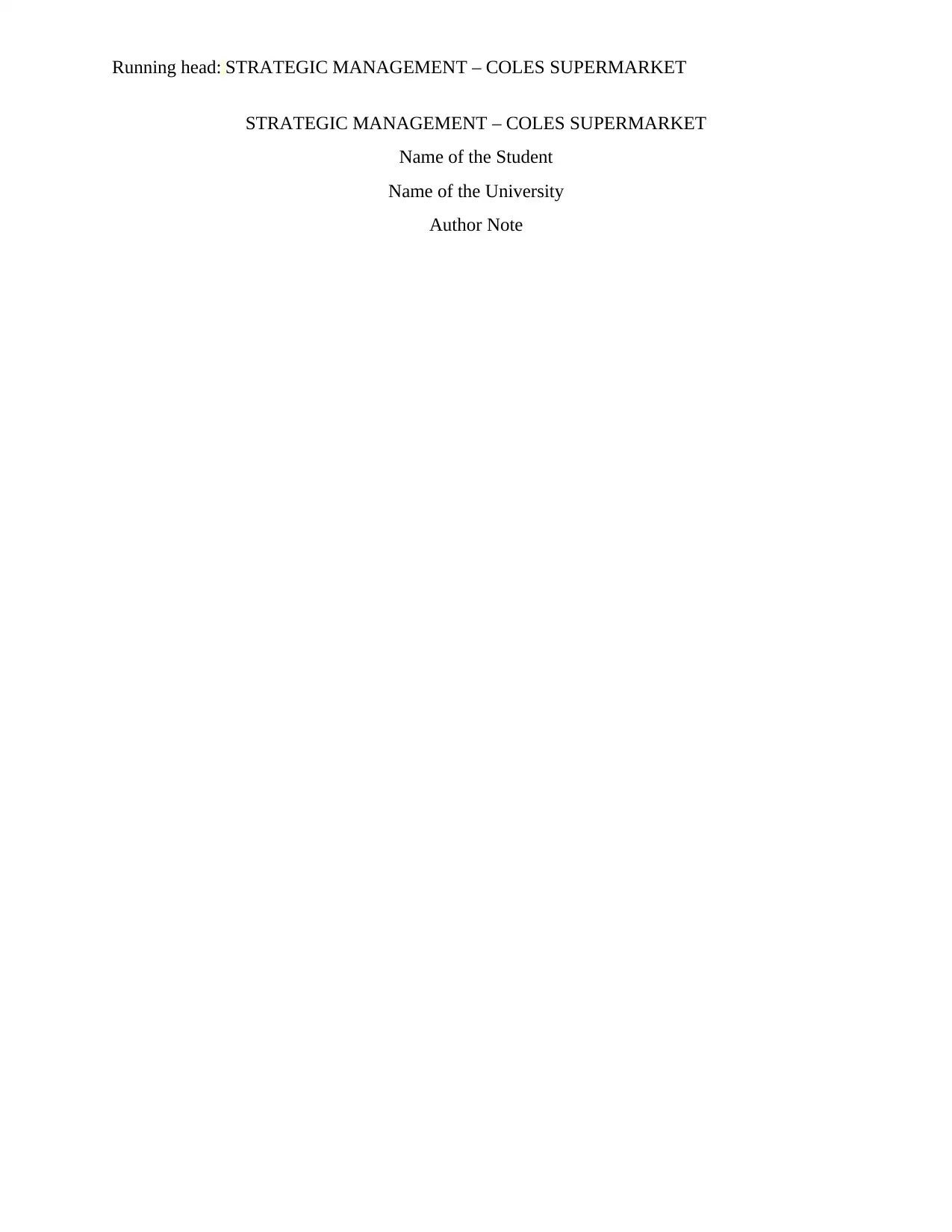
Running head: STRATEGIC MANAGEMENT – COLES SUPERMARKET
STRATEGIC MANAGEMENT – COLES SUPERMARKET
Name of the Student
Name of the University
Author Note
STRATEGIC MANAGEMENT – COLES SUPERMARKET
Name of the Student
Name of the University
Author Note
Paraphrase This Document
Need a fresh take? Get an instant paraphrase of this document with our AI Paraphraser
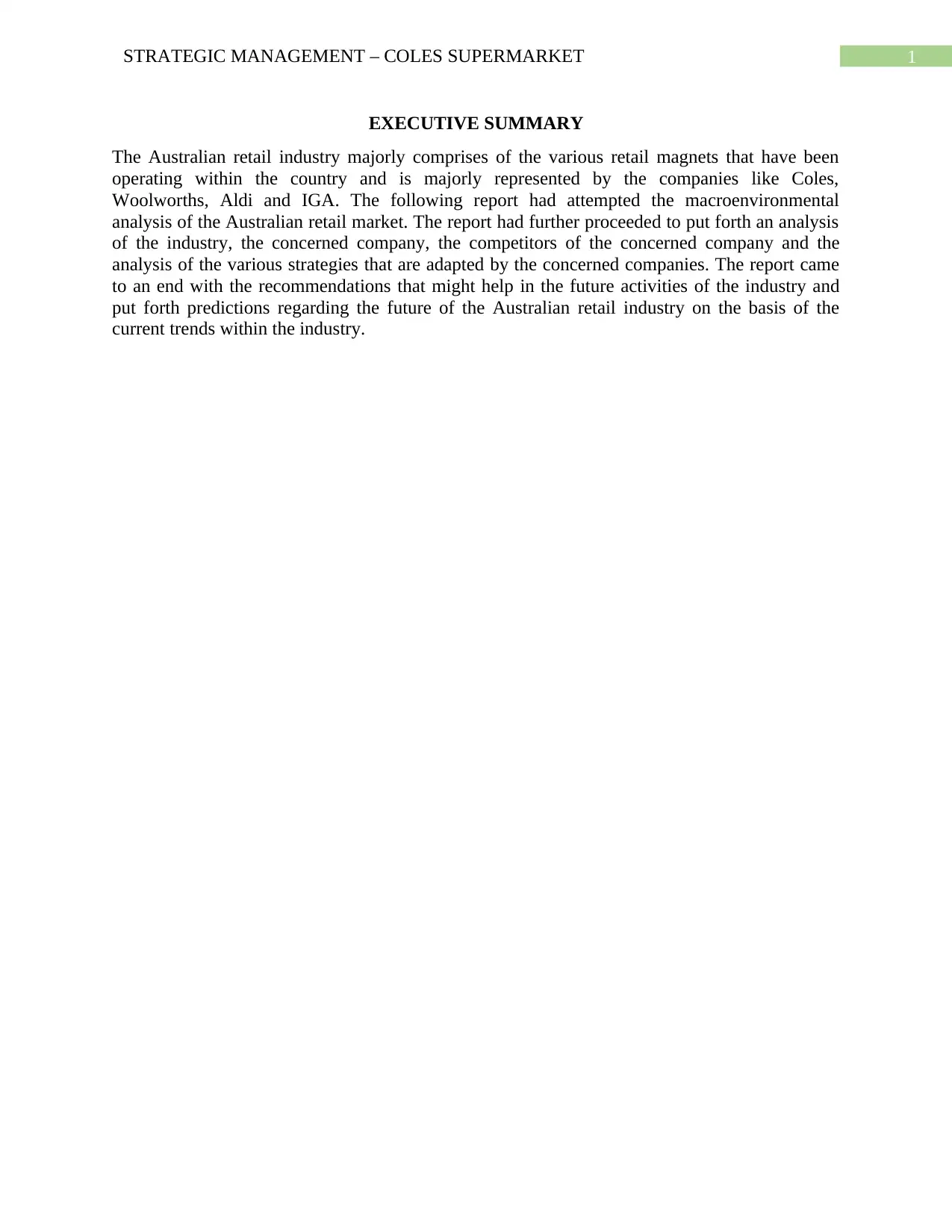
1STRATEGIC MANAGEMENT – COLES SUPERMARKET
EXECUTIVE SUMMARY
The Australian retail industry majorly comprises of the various retail magnets that have been
operating within the country and is majorly represented by the companies like Coles,
Woolworths, Aldi and IGA. The following report had attempted the macroenvironmental
analysis of the Australian retail market. The report had further proceeded to put forth an analysis
of the industry, the concerned company, the competitors of the concerned company and the
analysis of the various strategies that are adapted by the concerned companies. The report came
to an end with the recommendations that might help in the future activities of the industry and
put forth predictions regarding the future of the Australian retail industry on the basis of the
current trends within the industry.
EXECUTIVE SUMMARY
The Australian retail industry majorly comprises of the various retail magnets that have been
operating within the country and is majorly represented by the companies like Coles,
Woolworths, Aldi and IGA. The following report had attempted the macroenvironmental
analysis of the Australian retail market. The report had further proceeded to put forth an analysis
of the industry, the concerned company, the competitors of the concerned company and the
analysis of the various strategies that are adapted by the concerned companies. The report came
to an end with the recommendations that might help in the future activities of the industry and
put forth predictions regarding the future of the Australian retail industry on the basis of the
current trends within the industry.
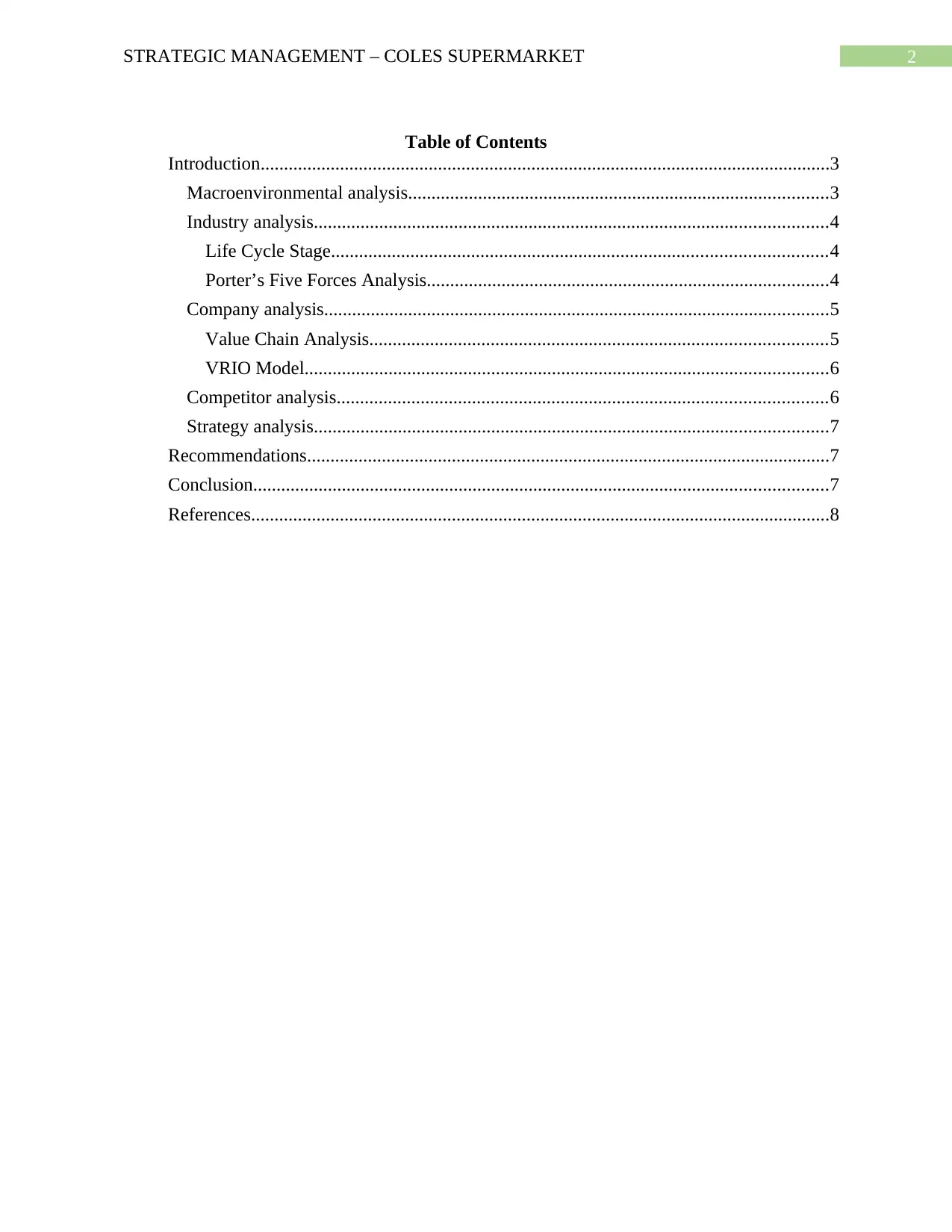
2STRATEGIC MANAGEMENT – COLES SUPERMARKET
Table of Contents
Introduction..........................................................................................................................3
Macroenvironmental analysis..........................................................................................3
Industry analysis..............................................................................................................4
Life Cycle Stage..........................................................................................................4
Porter’s Five Forces Analysis......................................................................................4
Company analysis............................................................................................................5
Value Chain Analysis..................................................................................................5
VRIO Model................................................................................................................6
Competitor analysis.........................................................................................................6
Strategy analysis..............................................................................................................7
Recommendations................................................................................................................7
Conclusion...........................................................................................................................7
References............................................................................................................................8
Table of Contents
Introduction..........................................................................................................................3
Macroenvironmental analysis..........................................................................................3
Industry analysis..............................................................................................................4
Life Cycle Stage..........................................................................................................4
Porter’s Five Forces Analysis......................................................................................4
Company analysis............................................................................................................5
Value Chain Analysis..................................................................................................5
VRIO Model................................................................................................................6
Competitor analysis.........................................................................................................6
Strategy analysis..............................................................................................................7
Recommendations................................................................................................................7
Conclusion...........................................................................................................................7
References............................................................................................................................8
⊘ This is a preview!⊘
Do you want full access?
Subscribe today to unlock all pages.

Trusted by 1+ million students worldwide
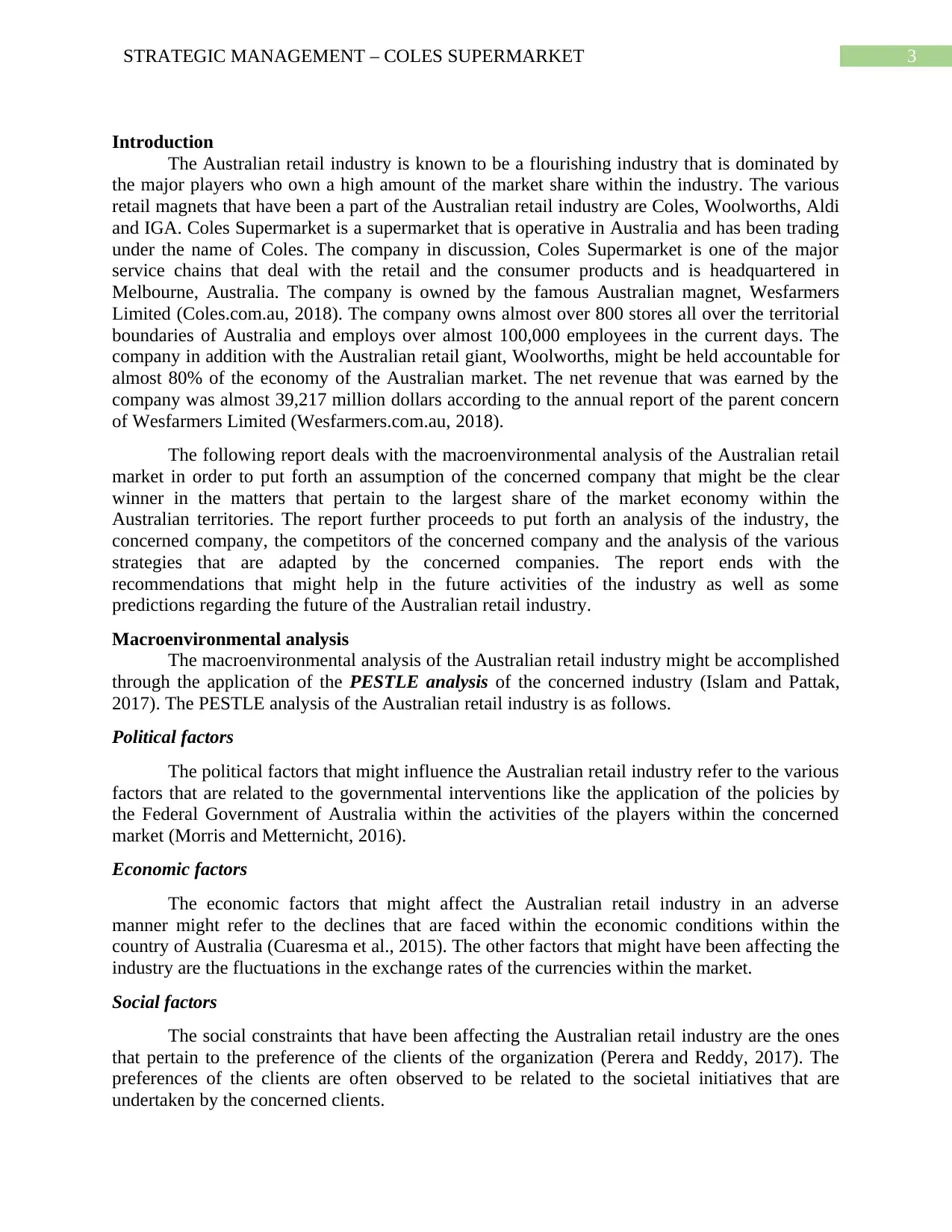
3STRATEGIC MANAGEMENT – COLES SUPERMARKET
Introduction
The Australian retail industry is known to be a flourishing industry that is dominated by
the major players who own a high amount of the market share within the industry. The various
retail magnets that have been a part of the Australian retail industry are Coles, Woolworths, Aldi
and IGA. Coles Supermarket is a supermarket that is operative in Australia and has been trading
under the name of Coles. The company in discussion, Coles Supermarket is one of the major
service chains that deal with the retail and the consumer products and is headquartered in
Melbourne, Australia. The company is owned by the famous Australian magnet, Wesfarmers
Limited (Coles.com.au, 2018). The company owns almost over 800 stores all over the territorial
boundaries of Australia and employs over almost 100,000 employees in the current days. The
company in addition with the Australian retail giant, Woolworths, might be held accountable for
almost 80% of the economy of the Australian market. The net revenue that was earned by the
company was almost 39,217 million dollars according to the annual report of the parent concern
of Wesfarmers Limited (Wesfarmers.com.au, 2018).
The following report deals with the macroenvironmental analysis of the Australian retail
market in order to put forth an assumption of the concerned company that might be the clear
winner in the matters that pertain to the largest share of the market economy within the
Australian territories. The report further proceeds to put forth an analysis of the industry, the
concerned company, the competitors of the concerned company and the analysis of the various
strategies that are adapted by the concerned companies. The report ends with the
recommendations that might help in the future activities of the industry as well as some
predictions regarding the future of the Australian retail industry.
Macroenvironmental analysis
The macroenvironmental analysis of the Australian retail industry might be accomplished
through the application of the PESTLE analysis of the concerned industry (Islam and Pattak,
2017). The PESTLE analysis of the Australian retail industry is as follows.
Political factors
The political factors that might influence the Australian retail industry refer to the various
factors that are related to the governmental interventions like the application of the policies by
the Federal Government of Australia within the activities of the players within the concerned
market (Morris and Metternicht, 2016).
Economic factors
The economic factors that might affect the Australian retail industry in an adverse
manner might refer to the declines that are faced within the economic conditions within the
country of Australia (Cuaresma et al., 2015). The other factors that might have been affecting the
industry are the fluctuations in the exchange rates of the currencies within the market.
Social factors
The social constraints that have been affecting the Australian retail industry are the ones
that pertain to the preference of the clients of the organization (Perera and Reddy, 2017). The
preferences of the clients are often observed to be related to the societal initiatives that are
undertaken by the concerned clients.
Introduction
The Australian retail industry is known to be a flourishing industry that is dominated by
the major players who own a high amount of the market share within the industry. The various
retail magnets that have been a part of the Australian retail industry are Coles, Woolworths, Aldi
and IGA. Coles Supermarket is a supermarket that is operative in Australia and has been trading
under the name of Coles. The company in discussion, Coles Supermarket is one of the major
service chains that deal with the retail and the consumer products and is headquartered in
Melbourne, Australia. The company is owned by the famous Australian magnet, Wesfarmers
Limited (Coles.com.au, 2018). The company owns almost over 800 stores all over the territorial
boundaries of Australia and employs over almost 100,000 employees in the current days. The
company in addition with the Australian retail giant, Woolworths, might be held accountable for
almost 80% of the economy of the Australian market. The net revenue that was earned by the
company was almost 39,217 million dollars according to the annual report of the parent concern
of Wesfarmers Limited (Wesfarmers.com.au, 2018).
The following report deals with the macroenvironmental analysis of the Australian retail
market in order to put forth an assumption of the concerned company that might be the clear
winner in the matters that pertain to the largest share of the market economy within the
Australian territories. The report further proceeds to put forth an analysis of the industry, the
concerned company, the competitors of the concerned company and the analysis of the various
strategies that are adapted by the concerned companies. The report ends with the
recommendations that might help in the future activities of the industry as well as some
predictions regarding the future of the Australian retail industry.
Macroenvironmental analysis
The macroenvironmental analysis of the Australian retail industry might be accomplished
through the application of the PESTLE analysis of the concerned industry (Islam and Pattak,
2017). The PESTLE analysis of the Australian retail industry is as follows.
Political factors
The political factors that might influence the Australian retail industry refer to the various
factors that are related to the governmental interventions like the application of the policies by
the Federal Government of Australia within the activities of the players within the concerned
market (Morris and Metternicht, 2016).
Economic factors
The economic factors that might affect the Australian retail industry in an adverse
manner might refer to the declines that are faced within the economic conditions within the
country of Australia (Cuaresma et al., 2015). The other factors that might have been affecting the
industry are the fluctuations in the exchange rates of the currencies within the market.
Social factors
The social constraints that have been affecting the Australian retail industry are the ones
that pertain to the preference of the clients of the organization (Perera and Reddy, 2017). The
preferences of the clients are often observed to be related to the societal initiatives that are
undertaken by the concerned clients.
Paraphrase This Document
Need a fresh take? Get an instant paraphrase of this document with our AI Paraphraser
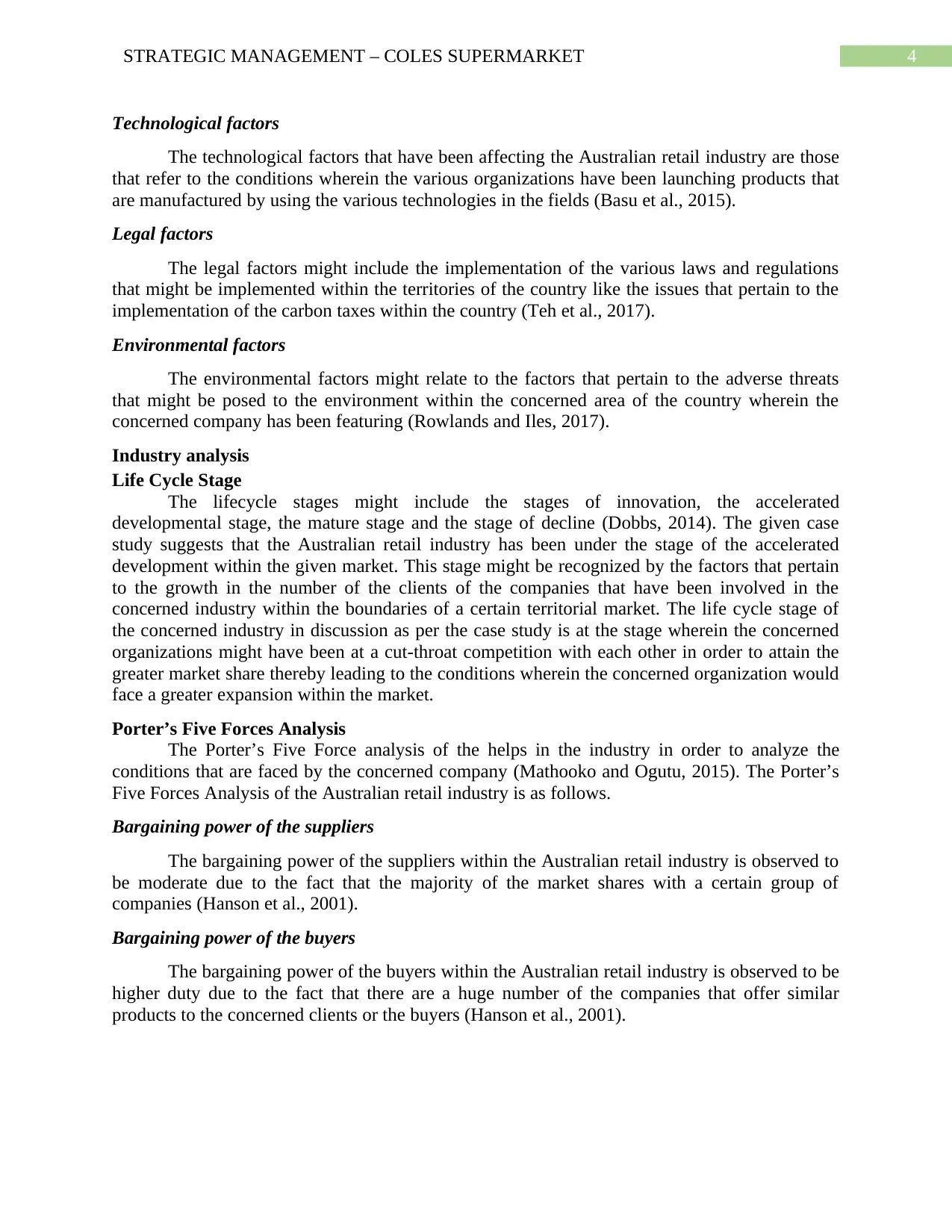
4STRATEGIC MANAGEMENT – COLES SUPERMARKET
Technological factors
The technological factors that have been affecting the Australian retail industry are those
that refer to the conditions wherein the various organizations have been launching products that
are manufactured by using the various technologies in the fields (Basu et al., 2015).
Legal factors
The legal factors might include the implementation of the various laws and regulations
that might be implemented within the territories of the country like the issues that pertain to the
implementation of the carbon taxes within the country (Teh et al., 2017).
Environmental factors
The environmental factors might relate to the factors that pertain to the adverse threats
that might be posed to the environment within the concerned area of the country wherein the
concerned company has been featuring (Rowlands and Iles, 2017).
Industry analysis
Life Cycle Stage
The lifecycle stages might include the stages of innovation, the accelerated
developmental stage, the mature stage and the stage of decline (Dobbs, 2014). The given case
study suggests that the Australian retail industry has been under the stage of the accelerated
development within the given market. This stage might be recognized by the factors that pertain
to the growth in the number of the clients of the companies that have been involved in the
concerned industry within the boundaries of a certain territorial market. The life cycle stage of
the concerned industry in discussion as per the case study is at the stage wherein the concerned
organizations might have been at a cut-throat competition with each other in order to attain the
greater market share thereby leading to the conditions wherein the concerned organization would
face a greater expansion within the market.
Porter’s Five Forces Analysis
The Porter’s Five Force analysis of the helps in the industry in order to analyze the
conditions that are faced by the concerned company (Mathooko and Ogutu, 2015). The Porter’s
Five Forces Analysis of the Australian retail industry is as follows.
Bargaining power of the suppliers
The bargaining power of the suppliers within the Australian retail industry is observed to
be moderate due to the fact that the majority of the market shares with a certain group of
companies (Hanson et al., 2001).
Bargaining power of the buyers
The bargaining power of the buyers within the Australian retail industry is observed to be
higher duty due to the fact that there are a huge number of the companies that offer similar
products to the concerned clients or the buyers (Hanson et al., 2001).
Technological factors
The technological factors that have been affecting the Australian retail industry are those
that refer to the conditions wherein the various organizations have been launching products that
are manufactured by using the various technologies in the fields (Basu et al., 2015).
Legal factors
The legal factors might include the implementation of the various laws and regulations
that might be implemented within the territories of the country like the issues that pertain to the
implementation of the carbon taxes within the country (Teh et al., 2017).
Environmental factors
The environmental factors might relate to the factors that pertain to the adverse threats
that might be posed to the environment within the concerned area of the country wherein the
concerned company has been featuring (Rowlands and Iles, 2017).
Industry analysis
Life Cycle Stage
The lifecycle stages might include the stages of innovation, the accelerated
developmental stage, the mature stage and the stage of decline (Dobbs, 2014). The given case
study suggests that the Australian retail industry has been under the stage of the accelerated
development within the given market. This stage might be recognized by the factors that pertain
to the growth in the number of the clients of the companies that have been involved in the
concerned industry within the boundaries of a certain territorial market. The life cycle stage of
the concerned industry in discussion as per the case study is at the stage wherein the concerned
organizations might have been at a cut-throat competition with each other in order to attain the
greater market share thereby leading to the conditions wherein the concerned organization would
face a greater expansion within the market.
Porter’s Five Forces Analysis
The Porter’s Five Force analysis of the helps in the industry in order to analyze the
conditions that are faced by the concerned company (Mathooko and Ogutu, 2015). The Porter’s
Five Forces Analysis of the Australian retail industry is as follows.
Bargaining power of the suppliers
The bargaining power of the suppliers within the Australian retail industry is observed to
be moderate due to the fact that the majority of the market shares with a certain group of
companies (Hanson et al., 2001).
Bargaining power of the buyers
The bargaining power of the buyers within the Australian retail industry is observed to be
higher duty due to the fact that there are a huge number of the companies that offer similar
products to the concerned clients or the buyers (Hanson et al., 2001).
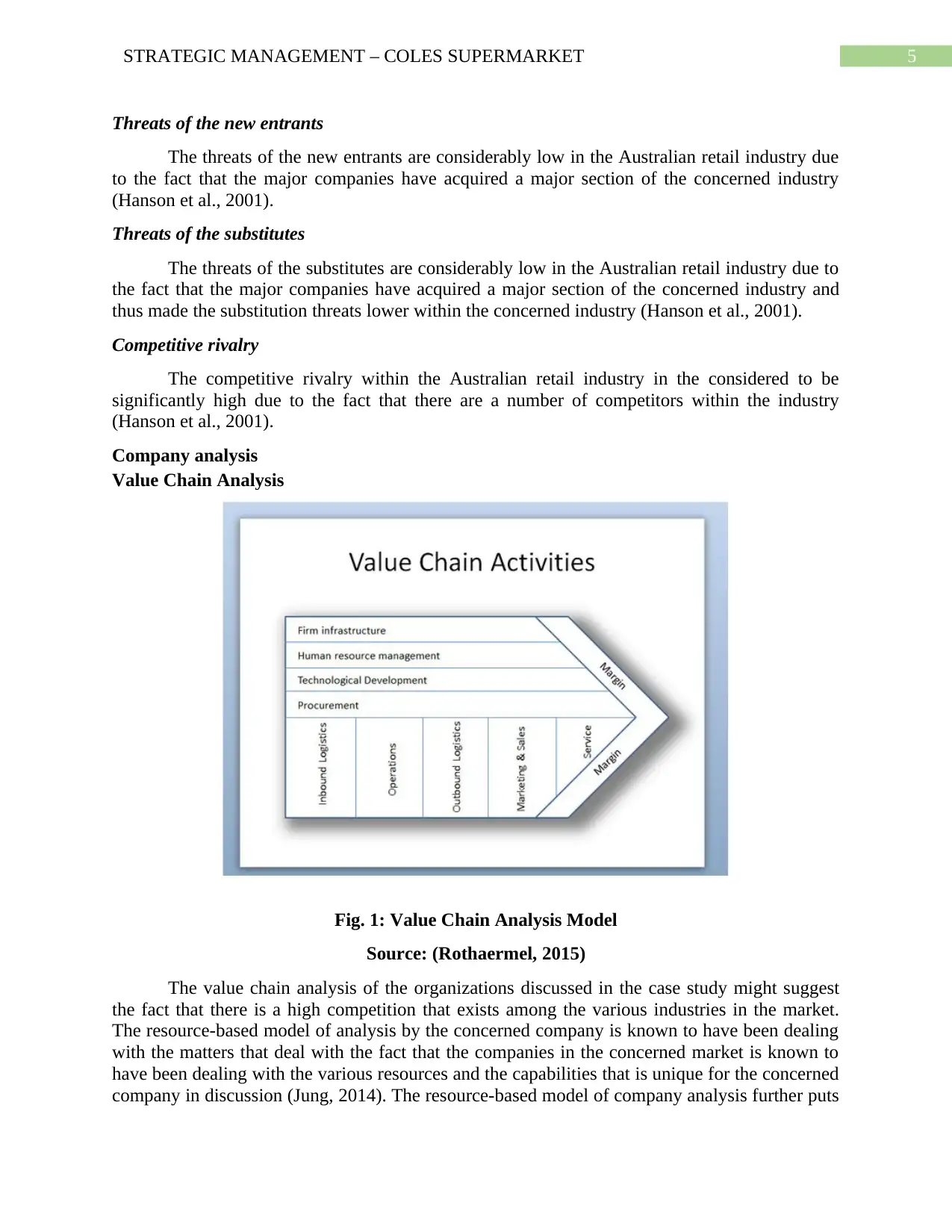
5STRATEGIC MANAGEMENT – COLES SUPERMARKET
Threats of the new entrants
The threats of the new entrants are considerably low in the Australian retail industry due
to the fact that the major companies have acquired a major section of the concerned industry
(Hanson et al., 2001).
Threats of the substitutes
The threats of the substitutes are considerably low in the Australian retail industry due to
the fact that the major companies have acquired a major section of the concerned industry and
thus made the substitution threats lower within the concerned industry (Hanson et al., 2001).
Competitive rivalry
The competitive rivalry within the Australian retail industry in the considered to be
significantly high due to the fact that there are a number of competitors within the industry
(Hanson et al., 2001).
Company analysis
Value Chain Analysis
Fig. 1: Value Chain Analysis Model
Source: (Rothaermel, 2015)
The value chain analysis of the organizations discussed in the case study might suggest
the fact that there is a high competition that exists among the various industries in the market.
The resource-based model of analysis by the concerned company is known to have been dealing
with the matters that deal with the fact that the companies in the concerned market is known to
have been dealing with the various resources and the capabilities that is unique for the concerned
company in discussion (Jung, 2014). The resource-based model of company analysis further puts
Threats of the new entrants
The threats of the new entrants are considerably low in the Australian retail industry due
to the fact that the major companies have acquired a major section of the concerned industry
(Hanson et al., 2001).
Threats of the substitutes
The threats of the substitutes are considerably low in the Australian retail industry due to
the fact that the major companies have acquired a major section of the concerned industry and
thus made the substitution threats lower within the concerned industry (Hanson et al., 2001).
Competitive rivalry
The competitive rivalry within the Australian retail industry in the considered to be
significantly high due to the fact that there are a number of competitors within the industry
(Hanson et al., 2001).
Company analysis
Value Chain Analysis
Fig. 1: Value Chain Analysis Model
Source: (Rothaermel, 2015)
The value chain analysis of the organizations discussed in the case study might suggest
the fact that there is a high competition that exists among the various industries in the market.
The resource-based model of analysis by the concerned company is known to have been dealing
with the matters that deal with the fact that the companies in the concerned market is known to
have been dealing with the various resources and the capabilities that is unique for the concerned
company in discussion (Jung, 2014). The resource-based model of company analysis further puts
⊘ This is a preview!⊘
Do you want full access?
Subscribe today to unlock all pages.

Trusted by 1+ million students worldwide
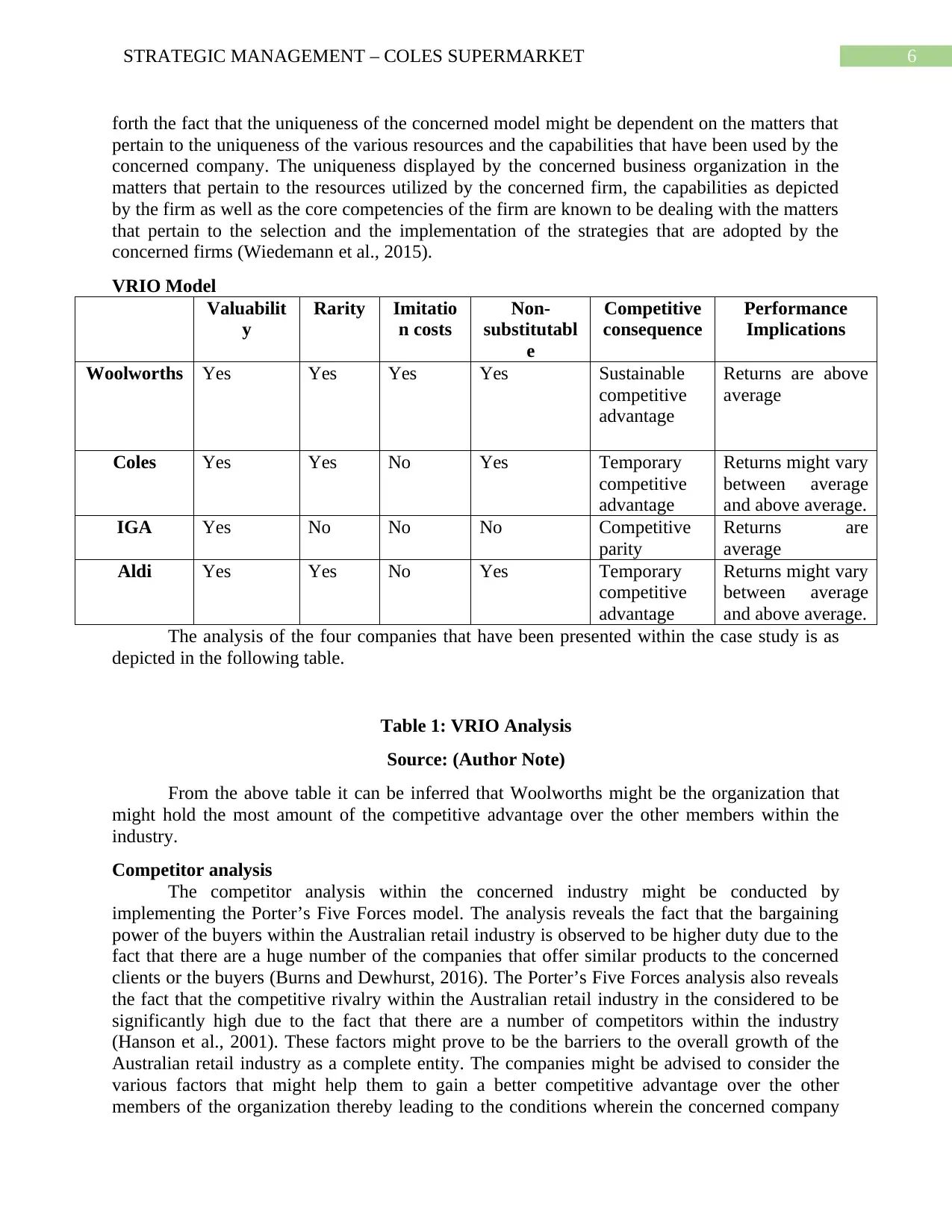
6STRATEGIC MANAGEMENT – COLES SUPERMARKET
forth the fact that the uniqueness of the concerned model might be dependent on the matters that
pertain to the uniqueness of the various resources and the capabilities that have been used by the
concerned company. The uniqueness displayed by the concerned business organization in the
matters that pertain to the resources utilized by the concerned firm, the capabilities as depicted
by the firm as well as the core competencies of the firm are known to be dealing with the matters
that pertain to the selection and the implementation of the strategies that are adopted by the
concerned firms (Wiedemann et al., 2015).
VRIO Model
Valuabilit
y
Rarity Imitatio
n costs
Non-
substitutabl
e
Competitive
consequence
Performance
Implications
Woolworths Yes Yes Yes Yes Sustainable
competitive
advantage
Returns are above
average
Coles Yes Yes No Yes Temporary
competitive
advantage
Returns might vary
between average
and above average.
IGA Yes No No No Competitive
parity
Returns are
average
Aldi Yes Yes No Yes Temporary
competitive
advantage
Returns might vary
between average
and above average.
The analysis of the four companies that have been presented within the case study is as
depicted in the following table.
Table 1: VRIO Analysis
Source: (Author Note)
From the above table it can be inferred that Woolworths might be the organization that
might hold the most amount of the competitive advantage over the other members within the
industry.
Competitor analysis
The competitor analysis within the concerned industry might be conducted by
implementing the Porter’s Five Forces model. The analysis reveals the fact that the bargaining
power of the buyers within the Australian retail industry is observed to be higher duty due to the
fact that there are a huge number of the companies that offer similar products to the concerned
clients or the buyers (Burns and Dewhurst, 2016). The Porter’s Five Forces analysis also reveals
the fact that the competitive rivalry within the Australian retail industry in the considered to be
significantly high due to the fact that there are a number of competitors within the industry
(Hanson et al., 2001). These factors might prove to be the barriers to the overall growth of the
Australian retail industry as a complete entity. The companies might be advised to consider the
various factors that might help them to gain a better competitive advantage over the other
members of the organization thereby leading to the conditions wherein the concerned company
forth the fact that the uniqueness of the concerned model might be dependent on the matters that
pertain to the uniqueness of the various resources and the capabilities that have been used by the
concerned company. The uniqueness displayed by the concerned business organization in the
matters that pertain to the resources utilized by the concerned firm, the capabilities as depicted
by the firm as well as the core competencies of the firm are known to be dealing with the matters
that pertain to the selection and the implementation of the strategies that are adopted by the
concerned firms (Wiedemann et al., 2015).
VRIO Model
Valuabilit
y
Rarity Imitatio
n costs
Non-
substitutabl
e
Competitive
consequence
Performance
Implications
Woolworths Yes Yes Yes Yes Sustainable
competitive
advantage
Returns are above
average
Coles Yes Yes No Yes Temporary
competitive
advantage
Returns might vary
between average
and above average.
IGA Yes No No No Competitive
parity
Returns are
average
Aldi Yes Yes No Yes Temporary
competitive
advantage
Returns might vary
between average
and above average.
The analysis of the four companies that have been presented within the case study is as
depicted in the following table.
Table 1: VRIO Analysis
Source: (Author Note)
From the above table it can be inferred that Woolworths might be the organization that
might hold the most amount of the competitive advantage over the other members within the
industry.
Competitor analysis
The competitor analysis within the concerned industry might be conducted by
implementing the Porter’s Five Forces model. The analysis reveals the fact that the bargaining
power of the buyers within the Australian retail industry is observed to be higher duty due to the
fact that there are a huge number of the companies that offer similar products to the concerned
clients or the buyers (Burns and Dewhurst, 2016). The Porter’s Five Forces analysis also reveals
the fact that the competitive rivalry within the Australian retail industry in the considered to be
significantly high due to the fact that there are a number of competitors within the industry
(Hanson et al., 2001). These factors might prove to be the barriers to the overall growth of the
Australian retail industry as a complete entity. The companies might be advised to consider the
various factors that might help them to gain a better competitive advantage over the other
members of the organization thereby leading to the conditions wherein the concerned company
Paraphrase This Document
Need a fresh take? Get an instant paraphrase of this document with our AI Paraphraser
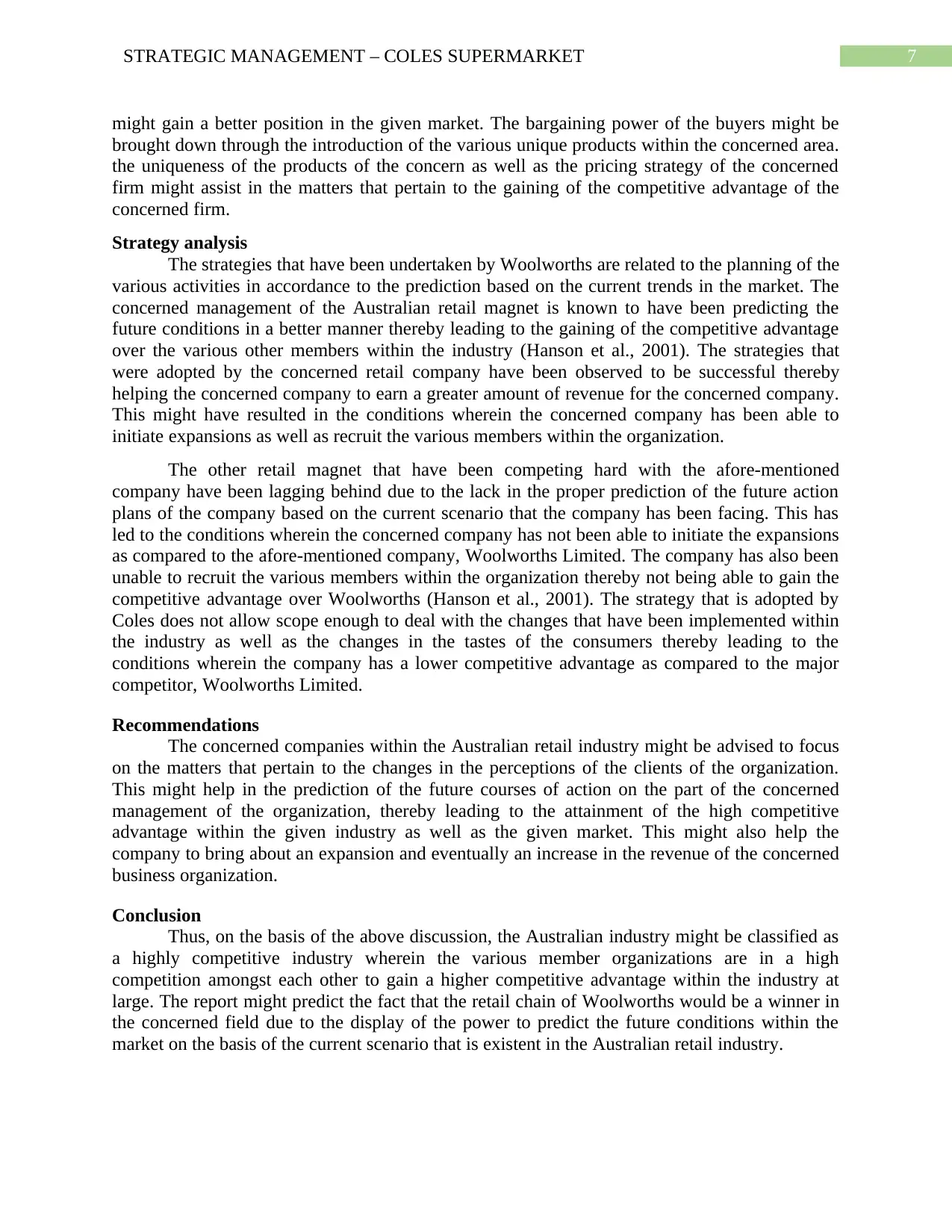
7STRATEGIC MANAGEMENT – COLES SUPERMARKET
might gain a better position in the given market. The bargaining power of the buyers might be
brought down through the introduction of the various unique products within the concerned area.
the uniqueness of the products of the concern as well as the pricing strategy of the concerned
firm might assist in the matters that pertain to the gaining of the competitive advantage of the
concerned firm.
Strategy analysis
The strategies that have been undertaken by Woolworths are related to the planning of the
various activities in accordance to the prediction based on the current trends in the market. The
concerned management of the Australian retail magnet is known to have been predicting the
future conditions in a better manner thereby leading to the gaining of the competitive advantage
over the various other members within the industry (Hanson et al., 2001). The strategies that
were adopted by the concerned retail company have been observed to be successful thereby
helping the concerned company to earn a greater amount of revenue for the concerned company.
This might have resulted in the conditions wherein the concerned company has been able to
initiate expansions as well as recruit the various members within the organization.
The other retail magnet that have been competing hard with the afore-mentioned
company have been lagging behind due to the lack in the proper prediction of the future action
plans of the company based on the current scenario that the company has been facing. This has
led to the conditions wherein the concerned company has not been able to initiate the expansions
as compared to the afore-mentioned company, Woolworths Limited. The company has also been
unable to recruit the various members within the organization thereby not being able to gain the
competitive advantage over Woolworths (Hanson et al., 2001). The strategy that is adopted by
Coles does not allow scope enough to deal with the changes that have been implemented within
the industry as well as the changes in the tastes of the consumers thereby leading to the
conditions wherein the company has a lower competitive advantage as compared to the major
competitor, Woolworths Limited.
Recommendations
The concerned companies within the Australian retail industry might be advised to focus
on the matters that pertain to the changes in the perceptions of the clients of the organization.
This might help in the prediction of the future courses of action on the part of the concerned
management of the organization, thereby leading to the attainment of the high competitive
advantage within the given industry as well as the given market. This might also help the
company to bring about an expansion and eventually an increase in the revenue of the concerned
business organization.
Conclusion
Thus, on the basis of the above discussion, the Australian industry might be classified as
a highly competitive industry wherein the various member organizations are in a high
competition amongst each other to gain a higher competitive advantage within the industry at
large. The report might predict the fact that the retail chain of Woolworths would be a winner in
the concerned field due to the display of the power to predict the future conditions within the
market on the basis of the current scenario that is existent in the Australian retail industry.
might gain a better position in the given market. The bargaining power of the buyers might be
brought down through the introduction of the various unique products within the concerned area.
the uniqueness of the products of the concern as well as the pricing strategy of the concerned
firm might assist in the matters that pertain to the gaining of the competitive advantage of the
concerned firm.
Strategy analysis
The strategies that have been undertaken by Woolworths are related to the planning of the
various activities in accordance to the prediction based on the current trends in the market. The
concerned management of the Australian retail magnet is known to have been predicting the
future conditions in a better manner thereby leading to the gaining of the competitive advantage
over the various other members within the industry (Hanson et al., 2001). The strategies that
were adopted by the concerned retail company have been observed to be successful thereby
helping the concerned company to earn a greater amount of revenue for the concerned company.
This might have resulted in the conditions wherein the concerned company has been able to
initiate expansions as well as recruit the various members within the organization.
The other retail magnet that have been competing hard with the afore-mentioned
company have been lagging behind due to the lack in the proper prediction of the future action
plans of the company based on the current scenario that the company has been facing. This has
led to the conditions wherein the concerned company has not been able to initiate the expansions
as compared to the afore-mentioned company, Woolworths Limited. The company has also been
unable to recruit the various members within the organization thereby not being able to gain the
competitive advantage over Woolworths (Hanson et al., 2001). The strategy that is adopted by
Coles does not allow scope enough to deal with the changes that have been implemented within
the industry as well as the changes in the tastes of the consumers thereby leading to the
conditions wherein the company has a lower competitive advantage as compared to the major
competitor, Woolworths Limited.
Recommendations
The concerned companies within the Australian retail industry might be advised to focus
on the matters that pertain to the changes in the perceptions of the clients of the organization.
This might help in the prediction of the future courses of action on the part of the concerned
management of the organization, thereby leading to the attainment of the high competitive
advantage within the given industry as well as the given market. This might also help the
company to bring about an expansion and eventually an increase in the revenue of the concerned
business organization.
Conclusion
Thus, on the basis of the above discussion, the Australian industry might be classified as
a highly competitive industry wherein the various member organizations are in a high
competition amongst each other to gain a higher competitive advantage within the industry at
large. The report might predict the fact that the retail chain of Woolworths would be a winner in
the concerned field due to the display of the power to predict the future conditions within the
market on the basis of the current scenario that is existent in the Australian retail industry.
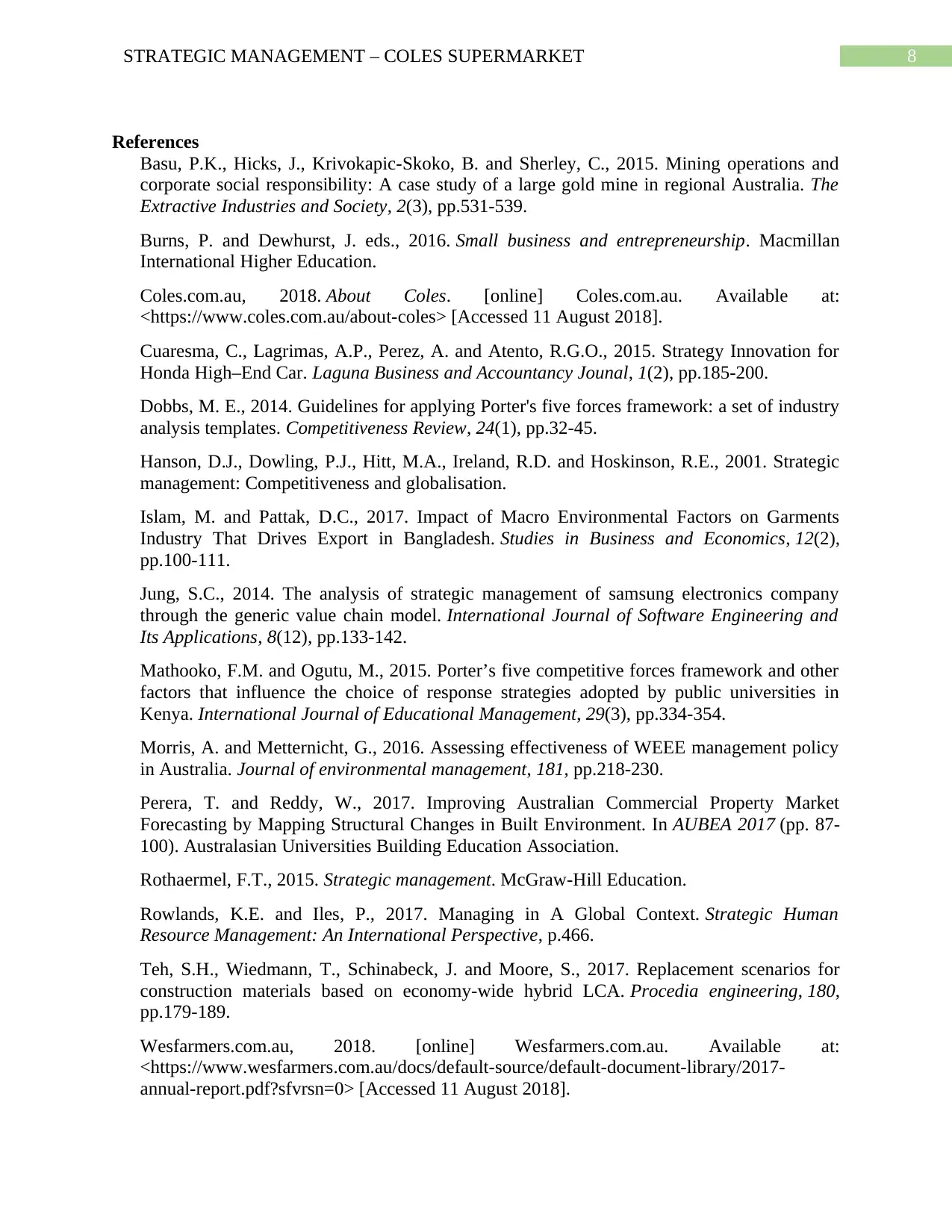
8STRATEGIC MANAGEMENT – COLES SUPERMARKET
References
Basu, P.K., Hicks, J., Krivokapic-Skoko, B. and Sherley, C., 2015. Mining operations and
corporate social responsibility: A case study of a large gold mine in regional Australia. The
Extractive Industries and Society, 2(3), pp.531-539.
Burns, P. and Dewhurst, J. eds., 2016. Small business and entrepreneurship. Macmillan
International Higher Education.
Coles.com.au, 2018. About Coles. [online] Coles.com.au. Available at:
<https://www.coles.com.au/about-coles> [Accessed 11 August 2018].
Cuaresma, C., Lagrimas, A.P., Perez, A. and Atento, R.G.O., 2015. Strategy Innovation for
Honda High–End Car. Laguna Business and Accountancy Jounal, 1(2), pp.185-200.
Dobbs, M. E., 2014. Guidelines for applying Porter's five forces framework: a set of industry
analysis templates. Competitiveness Review, 24(1), pp.32-45.
Hanson, D.J., Dowling, P.J., Hitt, M.A., Ireland, R.D. and Hoskinson, R.E., 2001. Strategic
management: Competitiveness and globalisation.
Islam, M. and Pattak, D.C., 2017. Impact of Macro Environmental Factors on Garments
Industry That Drives Export in Bangladesh. Studies in Business and Economics, 12(2),
pp.100-111.
Jung, S.C., 2014. The analysis of strategic management of samsung electronics company
through the generic value chain model. International Journal of Software Engineering and
Its Applications, 8(12), pp.133-142.
Mathooko, F.M. and Ogutu, M., 2015. Porter’s five competitive forces framework and other
factors that influence the choice of response strategies adopted by public universities in
Kenya. International Journal of Educational Management, 29(3), pp.334-354.
Morris, A. and Metternicht, G., 2016. Assessing effectiveness of WEEE management policy
in Australia. Journal of environmental management, 181, pp.218-230.
Perera, T. and Reddy, W., 2017. Improving Australian Commercial Property Market
Forecasting by Mapping Structural Changes in Built Environment. In AUBEA 2017 (pp. 87-
100). Australasian Universities Building Education Association.
Rothaermel, F.T., 2015. Strategic management. McGraw-Hill Education.
Rowlands, K.E. and Iles, P., 2017. Managing in A Global Context. Strategic Human
Resource Management: An International Perspective, p.466.
Teh, S.H., Wiedmann, T., Schinabeck, J. and Moore, S., 2017. Replacement scenarios for
construction materials based on economy-wide hybrid LCA. Procedia engineering, 180,
pp.179-189.
Wesfarmers.com.au, 2018. [online] Wesfarmers.com.au. Available at:
<https://www.wesfarmers.com.au/docs/default-source/default-document-library/2017-
annual-report.pdf?sfvrsn=0> [Accessed 11 August 2018].
References
Basu, P.K., Hicks, J., Krivokapic-Skoko, B. and Sherley, C., 2015. Mining operations and
corporate social responsibility: A case study of a large gold mine in regional Australia. The
Extractive Industries and Society, 2(3), pp.531-539.
Burns, P. and Dewhurst, J. eds., 2016. Small business and entrepreneurship. Macmillan
International Higher Education.
Coles.com.au, 2018. About Coles. [online] Coles.com.au. Available at:
<https://www.coles.com.au/about-coles> [Accessed 11 August 2018].
Cuaresma, C., Lagrimas, A.P., Perez, A. and Atento, R.G.O., 2015. Strategy Innovation for
Honda High–End Car. Laguna Business and Accountancy Jounal, 1(2), pp.185-200.
Dobbs, M. E., 2014. Guidelines for applying Porter's five forces framework: a set of industry
analysis templates. Competitiveness Review, 24(1), pp.32-45.
Hanson, D.J., Dowling, P.J., Hitt, M.A., Ireland, R.D. and Hoskinson, R.E., 2001. Strategic
management: Competitiveness and globalisation.
Islam, M. and Pattak, D.C., 2017. Impact of Macro Environmental Factors on Garments
Industry That Drives Export in Bangladesh. Studies in Business and Economics, 12(2),
pp.100-111.
Jung, S.C., 2014. The analysis of strategic management of samsung electronics company
through the generic value chain model. International Journal of Software Engineering and
Its Applications, 8(12), pp.133-142.
Mathooko, F.M. and Ogutu, M., 2015. Porter’s five competitive forces framework and other
factors that influence the choice of response strategies adopted by public universities in
Kenya. International Journal of Educational Management, 29(3), pp.334-354.
Morris, A. and Metternicht, G., 2016. Assessing effectiveness of WEEE management policy
in Australia. Journal of environmental management, 181, pp.218-230.
Perera, T. and Reddy, W., 2017. Improving Australian Commercial Property Market
Forecasting by Mapping Structural Changes in Built Environment. In AUBEA 2017 (pp. 87-
100). Australasian Universities Building Education Association.
Rothaermel, F.T., 2015. Strategic management. McGraw-Hill Education.
Rowlands, K.E. and Iles, P., 2017. Managing in A Global Context. Strategic Human
Resource Management: An International Perspective, p.466.
Teh, S.H., Wiedmann, T., Schinabeck, J. and Moore, S., 2017. Replacement scenarios for
construction materials based on economy-wide hybrid LCA. Procedia engineering, 180,
pp.179-189.
Wesfarmers.com.au, 2018. [online] Wesfarmers.com.au. Available at:
<https://www.wesfarmers.com.au/docs/default-source/default-document-library/2017-
annual-report.pdf?sfvrsn=0> [Accessed 11 August 2018].
⊘ This is a preview!⊘
Do you want full access?
Subscribe today to unlock all pages.

Trusted by 1+ million students worldwide
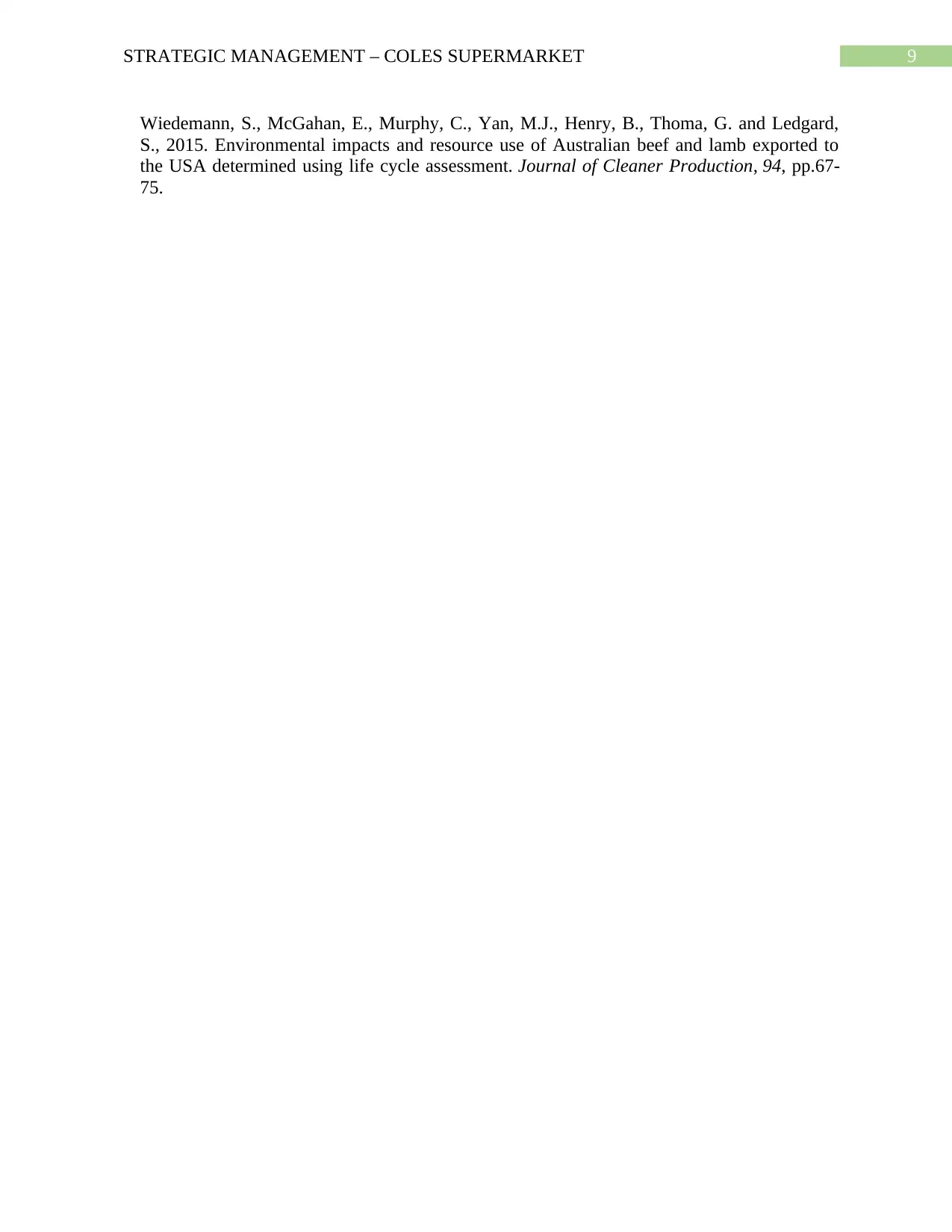
9STRATEGIC MANAGEMENT – COLES SUPERMARKET
Wiedemann, S., McGahan, E., Murphy, C., Yan, M.J., Henry, B., Thoma, G. and Ledgard,
S., 2015. Environmental impacts and resource use of Australian beef and lamb exported to
the USA determined using life cycle assessment. Journal of Cleaner Production, 94, pp.67-
75.
Wiedemann, S., McGahan, E., Murphy, C., Yan, M.J., Henry, B., Thoma, G. and Ledgard,
S., 2015. Environmental impacts and resource use of Australian beef and lamb exported to
the USA determined using life cycle assessment. Journal of Cleaner Production, 94, pp.67-
75.
1 out of 10
Related Documents
Your All-in-One AI-Powered Toolkit for Academic Success.
+13062052269
info@desklib.com
Available 24*7 on WhatsApp / Email
![[object Object]](/_next/static/media/star-bottom.7253800d.svg)
Unlock your academic potential
Copyright © 2020–2025 A2Z Services. All Rights Reserved. Developed and managed by ZUCOL.




